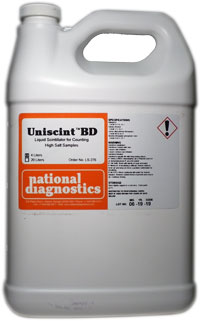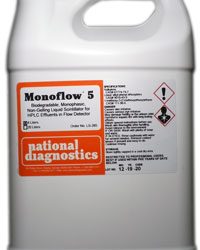Liquid Scintillation
Uniscint BD
$239.00 – $998.00
Catalog Number: LS-276
- Biodegradable Cocktail for HPLC Flow Detection High Salt Samples
- High Flash Point (>150°C)
- Reduced Toxicity Solvent
Description
Catalog Number: LS-276
- Biodegradable Cocktail for HPLC Flow Detection High Salt Samples
- High Flash Point (>150°C)
- Reduced Toxicity Solvent
Uniscint BD is a biodegradable scintillation solution specially formulated to accommodate high salt and buffer samples while still delivering efficiency. Uniscint BD has a low viscosity and is non-gelling. It is suited for use in online HPLC flow detectors as well as in traditional vial counting.
Uniscint BD accommodates all concentrations of ammonium phosphate up to 2M, at a ratio or 3:1 scintillator to sample, making it the ideal choice for counting ammonium phosphate gradients from 0-2M. Other samples, such as 2M ammonium formate and water are also accommodated at a 3:1 ratio.
| Sample | % Counting Efficiency |
|---|---|
| 2M Ammonium Persulfate | 33 |
| 2M Ammonium Phosphate | 32 |
| Water | 35 |
Additional information
| Weight | 9 lbs |
|---|---|
| Dimensions | 15 × 10 × 13 in |
Safety Overview
Safety Summary (see SDS for complete information before using product):
Appearance and Odor
Aromatic hydrocarbons and surfactants with scintillation phosphors.
EMERGENCY OVERVIEW – IMMEDIATE HAZARD
Nalkylene
MAY BE IRRITATING TO THE SKIN, EYES, AND RESPIRATORY TRACT.
Alcohol ethoxylate phosphate ester
CAUSES EYE IRRITATION. MAY CAUSE RESPIRATORY TRACT IRRITATION.
Butoxy Ethanol
CAUTION! SEVERELY IRRITATING TO THE EYES. IRRITATING TO THE SKIN, NOSE THROAT AND RESPIRATORY TRACT. TOXIC IF INHALED, INGESTED OR ABSORBED THROUGH SKIN.
Linear alkyl phenyl ethoxylates
CAUSES EYE IRRITATION. MAY CAUSE RESPIRATORY TRACT IRRITATION.
EMERGENCY OVERVIEW – CHRONIC HAZARD WARNING
Nalkylene
NO CHRONIC HEALTH HAZARDS KNOWN.
Alcohol ethoxylate phosphate ester
NO ADVERSE EFFECTS HAVE BEEN DOCUMENTED IN HUMANS AS A RESULT OF CHRONIC EXPOSURE.
Butoxy Ethanol
NO INFORMATION FOUND.
Linear alkyl phenyl ethoxylates
NO ADVERSE EFFECTS HAVE BEEN DOCUMENTED IN HUMANS AS A RESULT OF CHRONIC EXPOSURE.
- Waste Disposal Issues in Scintillation Counting
- The Complete Scintillation Cocktail
- Radioactive Emissions and the Use of Isotopes in Research
- Preparing Tissue Samples for Scintillation Counting
- Preparing Samples in PAGE Gels for LSC
- Mechanism of Liquid Scintillation Counting
- Measurement of Radiation and Isotope Quantitation
- Liquid Scintillation Signal Interpretation
- Liquid Scintillation and Radiation Safety
- HPLC Flow Counting
- Counting Samples on Cellulose-Ester Filters
- Counting Samples from TLC Plates by LSC
- Counting Efficiency and Quenching
- Counting Carbon Dioxide by LSC
- Chemiluminescence and Static Electricity
- Assaying Discrete Samples by Liquid Scintillation Counting



